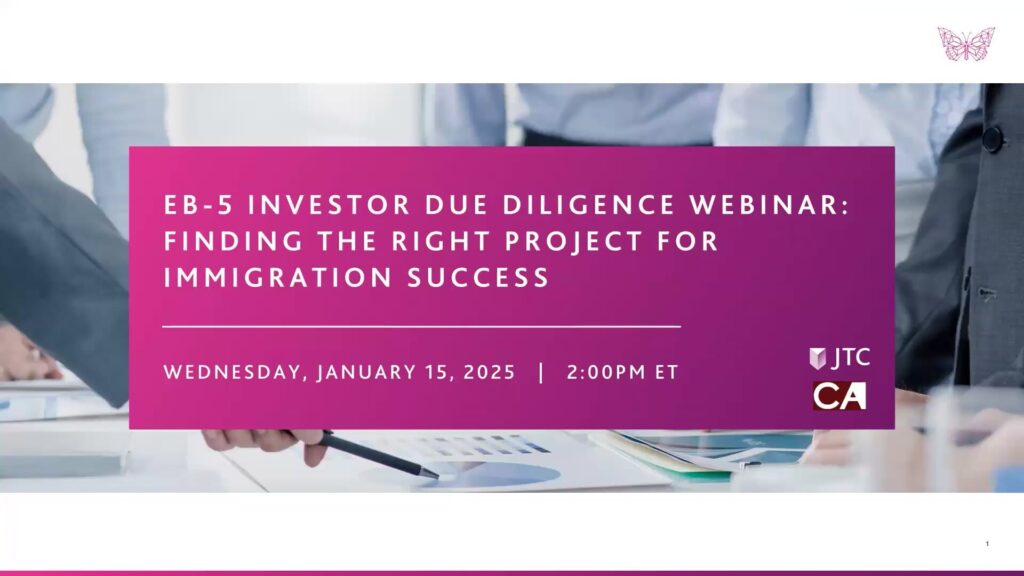
The EB-5 Immigrant Investor Program continues to be a gateway for international investors seeking U.S. residency while contributing to job creation and economic growth. As interest in EB-5 surges, due diligence remains critical to ensuring success in both immigration and investment outcomes. The recent webinar, hosted by JTC Group and CanAm Enterprises, “EB-5 Due Diligence: Finding the Right Project for Immigration Success”, was moderated by Christine Chen, Chief Operating Officer of CanAm, and brought together industry leaders to discuss what investors must consider when evaluating EB-5 projects. A detailed look at the insights shared by the panel appears below, or you can complete the form at the bottom of the page to watch a recording of the full webinar.
The EB-5 Program: A Dual Objective
Joey Barnett, Immigration Attorney at Wolfsdorf Rosenthal LLP, set the stage by outlining the dual nature of the EB-5 program: “To many immigrant investors, it’s a green card program because it allows you and your family to remain in the United States forever. But it’s also a job creation and investment program.”
This dual objective requires investors to approach EB-5 projects with a comprehensive understanding of both immigration and financial considerations. As Barnett explained, “Picking a good project is the most important aspect of EB-5. It’s more critical than the immigration attorney you work with or where the project is located because the project’s job creation is what ultimately gets you the green card.”
Download the Full White Paper: EB-5 Investor Due Diligence: Finding the Right Project for Immigration Success
The Evolution of EB-5 and Key Questions to Ask
Christine Chen highlighted the industry’s evolution under the 2022 EB-5 Reform and Integrity Act. “The program has come a long way, offering enhanced protections and transparency for investors,” she stated. Among these changes is the requirement for third-party oversight, such as fund administration, which ensures greater accountability.
Jill Jones, General Counsel at JTC, emphasized the role of fund administrators: “Fund administrators now co-sign disbursements, ensuring that funds are spent as intended. This layer of oversight provides investors with transparency and confidence that their money is being used to meet project milestones.”
Investors should prioritize the following questions during due diligence:
- Who is sponsoring the project? Understanding the track record and reputation of the regional center and project developer is crucial.
- Is the project fully financed? Walter Gindin, General Counsel at CanAm, noted that “strong capital stacks with sufficient equity contributions demonstrate a developer’s commitment and reduce risk.”
- What is the project’s job creation methodology? Suzanne Lazicki, President of Lucid Professional Writing, added, “You need to know if the project has realistic inputs for job creation, such as development expenditures and operating revenues.”
- What are the terms of the exit strategy? “The duration of other debts in the capital stack can influence a project’s ability to repay EB-5 investors,” Sebastian Stubbe, CEO of Pine State Regional Center, cautioned.
Immigration Success vs. Investment Security
Panelists highlighted the tension between immigration requirements and financial realities. For instance, while quick deployment of funds ensures job creation, investors must also verify that the project has met key milestones, such as securing permits. “You want to ensure that the project is shovel-ready and capable of sustaining the investment period,” said Barnett.
The sustainment requirement, or the period during which funds must remain invested, adds another layer of complexity. Lazicki explained: “The minimum period is typically two years, but practical realities mean investments are often tied up for longer. It’s crucial to evaluate the project’s timeline and economic viability to ensure both immigration and financial success.”
Risk Mitigation Through Oversight
The importance of third-party guarantees and fund administration was a recurring theme. “Guarantees, when structured correctly, can mitigate certain risks,” Barnett said. However, he cautioned against overreliance on guarantees: “You need to evaluate the guarantor’s financial capacity and the specific terms of the guarantee.”
Jones emphasized how fund administrators bridge the gap between investors and USCIS requirements: “We track every dollar from the investor’s account to the job-creating enterprise. Our reporting systems ensure that investors, regional centers, and USCIS have real-time visibility into the project’s financial health.”
Location and Market Viability
The location of an EB-5 project often attracts investors, but experts warned against choosing a project solely based on geography. Irina Rostova, founder of EB5support.com, shared: “Investors frequently ask for projects in specific states, but location alone doesn’t determine success. It’s about whether the project makes sense for that market.”
Site visits can provide valuable insights into a project’s feasibility. Rostova shared her approach: “When evaluating projects in unfamiliar areas, I visit the site to observe local economic activity, speak with developers, and assess demand. This level of due diligence is critical to understanding a project’s long-term viability.”
Balancing Risk and Return
The panel agreed that low returns are typical in EB-5 investments, as the program prioritizes risk mitigation. “High returns often indicate hidden risks,” Stubbe warned. “Focus on projects with institutional-grade equity investors who have a vested interest in the project’s success.”
Developers’ equity contributions, also known as “skin in the game,” are another key indicator of commitment. “You want to see meaningful equity from developers, not just nominal amounts,” Gindin explained. He also stressed the importance of monitoring the construction timeline to avoid delays that could jeopardize job creation.
The Importance of Expertise
A recurring theme throughout the webinar was the value of experienced professionals. “Having a strong legal and advisory team is critical,” Chen emphasized. “The right team can navigate USCIS regulations, evaluate project risks, and ensure that investors are making informed decisions.”
Barnett echoed this sentiment: “The choice of attorney, regional center, and fund administrator can make or break your EB-5 experience. This is not a process you want to navigate alone.”
Conclusion: Knowledge is Power
The webinar underscored that successful EB-5 investments require a thorough understanding of the program’s complexities. From assessing job creation methodologies to evaluating fund administrators and guarantees, due diligence is essential.
As Chen aptly summarized, “EB-5 is not just about buying a green card. It’s about making a real investment in America’s future. By asking the right questions and partnering with experienced professionals, investors can achieve both their immigration and financial goals.”
Investors looking to learn more about EB-5 due diligence can access the full webinar recording here. You can also read our white paper on this topic here.
Watch the full webinar
Dive Deeper Into EB-5:


